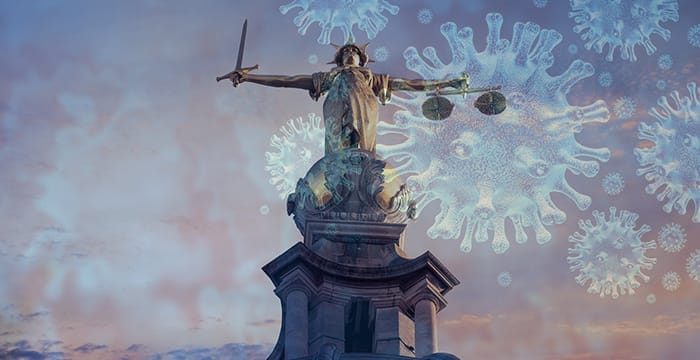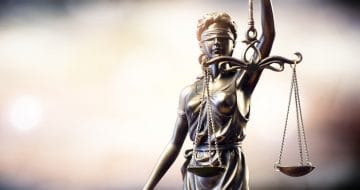Oxford law grad and aspiring barrister Jordan Briggs takes a look at the episodes of the last eight months in this first instalment of a three-part mini-series

This is the first of three articles in a mini-series. It will assess the extent to which the United Kingdom government’s legal response to the coronavirus pandemic complies with the rule of law. This article will explain what is meant by the ‘rule of law’ for our purposes, present a concise history of key coronavirus legislation, and begin the assessment itself.
What is the ‘rule of law’?
The meaning and content of rule of law is disputed. Some theorists adopt ‘formal’ conceptions, while others take ‘substantive’ views. On a ‘formal’ view, the rule of law is associated only with certain qualities about how the law is made, administered and adjudicated. So understood, the rule of law implies nothing about human rights, justice or equality.
‘Substantive’ conceptions go further. In addition to requiring the aforementioned formal qualities, the rule of law is understood to require observance of normatively desirable standards. As Tom Bingham memorably put it, “a state which savagely repressed or persecuted sections of its people could not in my view be regarded as observing the rule of law” (2010, The Rule of Law).
We lack space to invoke both ‘formal’ and ‘substantive’ conceptions to assess the United Kingdom government’s legal response to coronavirus. We must pick one.
We will use the ‘formal’ lens. This is for two reasons. First, the formal lens helpfully separates appraisal of laws’ formal qualities from questions about substantive merit. We already have procedures to assess a law’s substantive merit: ethical or moral inquiry. The rule of law, by contrast, is the only analytic tool which looks to formal qualities. The rule of law is more useful as a bespoke inquiry into laws’ formal qualities, than it is as a catch-all term for the normative desirability of particular legal orders. Second, formal conceptions tend to helpfully disaggregate the rule of law into discrete criteria. Thus, the formal conception allows us to methodically assess the government’s response against each criterion in turn, and absolves us from thereafter having to proceed into the swamps of substantive morality.
There are many formal accounts. I will use that set out by Joseph Raz in Chapter 11 of The Authority of Law (1979). This is because it captures the majority of formal touchstones popularly associated with the rule of law. There are eight touchstones:
(1) All laws should be prospective, open and clear;
(2) Laws should be relatively stable;
(3) The making of particular legal orders should be guided by open, stable and clear general rules;
(4) Independence of the judiciary should be guaranteed;
(5) The principles of natural justice should be observed;
(6) Courts should have review powers over the implementation of other principles;
(7) Courts should be easily accessible, and;
(8) The discretion of crime preventing agencies may not pervert the law.
The forthcoming analysis will analyse the facts of the government’s legal response to coronavirus against each criterion in turn.
Overview of coronavirus legislation
To prepare ourselves for that analysis, we should now familiarise ourselves with key coronavirus-related legislation. All were introduced or affected by the office of the present Secretary of State for Health and Social Care, Matt Hancock. Note that, in the main body of the article(s), to save space I refer to coronavirus-related statutory instruments by their abbreviations only.
• Coronavirus Act 2020. Took effect on 25 March 2020. Affected legislative and regulatory changes to support the United Kingdom’s pandemic response. Conferred broad discretionary powers on the government inter alia to restrict public gatherings, to take measures to assist the economy, to temporarily detain people suspected as being infectious (etc.)
• The Health Protection (Coronavirus, Restrictions) (England) Regulations 2020 (S.I. 2020/684). Took effect on 26 March 2020. Affected business closures. Restricted interpersonal ‘gatherings’ (i.e. two or more people coming together in order to engage in social interaction or to undertake an activity with each other, unless, inter alia, those individuals are members of the same household). Limited persons’ free movement (i.e. no person could leave their residence without ‘reasonable excuse’).
• The Health Protection (Coronavirus, Restrictions) (No. 2) (England) Regulations 2020 (S.I. 2020/750). Took effect on 4 July 2020. Replaced and relaxed S.I. 2020/684, above. Empowered Secretary of State for Health and Social Care to make legally-effective ‘declarations’ immediately restricting access to public outdoor places.
• The Health Protection (Coronavirus, Local COVID-19 Alert Level) (Medium) (England) Regulations 2020 (S.I. 2020/1103) [and equivalent provisions for ‘High’ (S.I. 2020/1004) and ‘Very High’ areas (S.I. 2020/1005)]. Took effect on 12 October 2020. Affected three different versions of restrictions throughout England, from Medium (least restrictive) to Very High (most restrictive). Restrictions related principally to multi-personal gatherings and business closures.
Want to write for the Legal Cheek Journal?
Find out more• The Health Protection (Coronavirus, Restrictions) (No. 4) (England) Regulations 2020 (S.I. 2020/1200). Took effect on 5 November 2020. Revoked the three-tier system. Affected a second nationwide lockdown in England. Affected reclosure of many businesses. Provided that no person may leave or be outside their residence without ‘reasonable excuse’. Re-enacted prohibitions on gatherings.
Duly prepared, we may now assess the extent to which the United Kingdom government’s legal response to coronavirus complies with the rule of law.
Criterion 1. ‘All laws should be prospective, open and clear’
The three elements of this criterion exist to guide us toward a society, protective of individual liberty, in which people can find out what the law is and plan their actions in accordance with it. The contrary situation – in which legal sanctions are imposed in respect of retroactive, opaque or secret laws — is repugnant.
As regards prospectivity, coronavirus laws have been so. That is, the laws regulate future acts only (i.e. do not impose liability in respect of past acts that were perfectly lawful when performed). By ‘openness’, Raz means that laws should be ‘adequately publicised’. Coronavirus laws are ‘open’ — they can be read for free at legislation.gov.uk.
Sadly, however, coronavirus laws are not ‘clear’. Four matters point towards this conclusion.
First, coronavirus laws are very long. The Coronavirus Act 2020 runs to 348 pages, has 102 sections and 29 schedules. The ‘three-tier’ system of lockdown comprised some 30,000 words, spread over three statutory instruments. Simply reading all this information is a challenge, to say nothing of understanding it.
Second, coronavirus laws are very numerous. At the time of writing, legislation.gov.uk yields 551 laws with the word ‘coronavirus’ in the title. Indeed, many statutory instruments exist simply to amend other, non-coronavirus-related secondary legislation on topics from income tax (S.I. 2020/524) to apprenticeships (S.I. 2020/1120) to offshore chemicals (S.I. 2020/855). One must now sift through a large volume of legal materials, if one is to discern the law to which one is subject.
Third, coronavirus laws contain vague language. Take, for example, ‘mingling’. ‘Mingling’ in a group of more than six people was prohibited (outside certain exempted situations) by S.I. 2020/986. This was the first proscription of interpersonal ‘mingling’, and the meaning of the word wasn’t clear. On 15 September 2020, Priti Patel (Secretary of State for the Home Department) asserted that the proscription disallowed two families of four people from stopping to chat while walking to a park. A contrary view was expressed by Adam Wagner (the human rights barrister and Specialist Advisor to the Joint Committee on Human Rights’ COVID-19 Inquiry) who tweeted that, to ‘mingle’, people must have met ‘in order’ to socially engage, which the park-goers will not have done. A law is not particularly ‘clear’ if specialists disagree about what it means.
Fourth, coronavirus laws can become confused with legally inconsequential government guidance. On 23 March 2020, Prime Minister Boris Johnson gave a televised address to the United Kingdom. Johnson instructed that “you must stay at home”, and presented “the only reasons you should leave your home” as a closed list (e.g. shopping for basic necessities; one form of exercise per day; medical need; travelling to and from work). At the time, none of this was law. Three days later, though, S.I. 2020/684 entered into force. Strikingly, the instrument provided that people could leave homes if they had a ‘reasonable excuse’ (the non-exhaustiveness of which differed from Johnson’s four given examples). Laws are not ‘clear’ if, owing to additional government guidance on the relevant issue, people are liable to become confused about the strict legal position. Particularly so when that additional guidance is communicated directly to the populace, in imperative terms, by the Prime Minister.
Notwithstanding their prospectivity and openness, coronavirus laws’ lack of clarity (associated with their length, volume, opacity and potential for conflation with mere guidance) disrupts individuals’ abilities to plan their lives in accordance with what is lawful. To that extent, the government’s response appears to deviate from what is required by the first criterion of Raz’s conception of rule of law.
Interim conclusion
This article has covered a lot of ground. We have discussed different understandings of the ‘rule of law’, and have selected Joseph Raz’s account for our purposes. We have surveyed key coronavirus legislation, and have begun analysing the extent to which the government’s legal response to coronavirus complies with the rule of law, drawing particular attention to the laws’ opacity. That’s quite enough for one day.
In the second instalment in this miniseries, we discuss five further criteria against which the government’s legal response may be judged. I hope to see you there.
Jordan Briggs graduated in law from the University of Oxford and began an LLM at the LSE in September. He is an aspiring barrister.




Please bear in mind that the authors of many Legal Cheek Journal pieces are at the beginning of their career. We'd be grateful if you could keep your comments constructive.